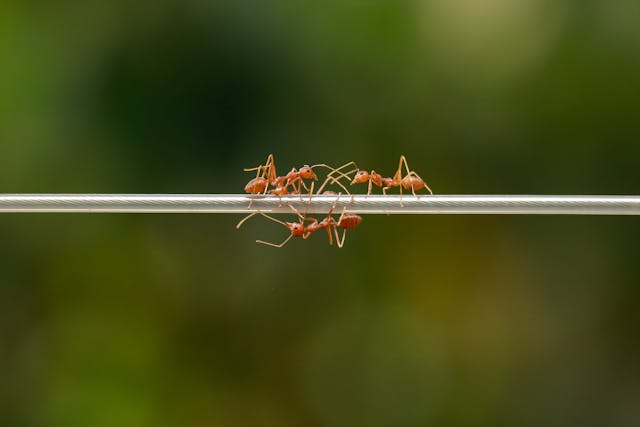
Why don’t army ants make nests? Army ants can clear an area of insects and food in a few days, so they have to keep on the mood to find more food.
Most species of ants build complex nests that have interlocking tunnels and chambers for different purposes. They have places to keep their larvae, places to store food, and other structures. They even have air vents that poke out through the ground to ventilate the nest. Ants can shift about fifty times their own weight, but they are pretty small, so one ant doesn’t move an awful lot of soil. It can take months, sometimes even a year before an ant nest is complete and even then it is constantly undergoing construction and repairs. The queen is always in a chamber in the very center of the nest, which is for safety. All of the ants in the colony have different jobs. Some of them find food, some of them fight, and some of them are responsible for building the nest.
Army ants don’t build nests. Before we look at why, lets look at what an army ant is. There are over 200 different species of army ants, but they all exhibit similar traits that make them interesting. The first is the amount of food they eat and the way they eat it. A regular ant colony has between 50,000 and 100,000 ants in it. They can consume a lot, but they never out consume the area they live in. An army ant colony has about 15 million ants living in it. They can catch and consume huge quantities of food. They do this in two ways. The first line of attack are the workers. They head out from wherever the colony is based and look for small insects. They generally target bees, wasps, other ants, and anything small they can find. They have strong mandibles and they can make short work of most small insects. The second line of attack are only found in a few species of army ants and they are called submajors. They have evolved to be much larger than the regular workers and they have long legs and very strong mandibles. They can catch and cut up much larger insects and spiders to be carried back by the regular workers. Because of their sheer numbers and the extra large ants, army ants can carry back about 3,000 insects an hour to the center of their colony, sometimes killing 500,000 in a day, and they will decimate any area that they travel through. When army ants move into an area, there is usually an exodus of insects moving out of the area.
The fact that army ants clear an entire area of insects when they arrive is the reason why they don’t make permanent nests like other ants do. If they lived in one place, they would run out of food within a few days. The only choice they have is to move to where the food is. The army ants tend to stay in one place and then move on about once every twenty days. So, while they are in one place, where do they live? That is the second fascinating thing about them. They live in a nest that they make out of their own bodies. It is called a bivouac. The stationary period lasts for as long as it takes for the queen’s eggs to develop. The queen lays her eggs and about ten days later, the ants make their bivouac. The queen stays inside it and the ants fetch food to feed her and the newly hatched larvae. When the larvae are developed enough, the ants move on.
So, how do army ants make a bivouac? They find a suitable place, which is somewhere like an overhanging rotten log. Workers at the top grip the log until they have completely covered it. Then, by gripping each other’s legs or bodies, the ants form a nest that hangs off the log and is made entirely of interlocked ants. There may be as many as 700,000 ants in the structure. Inside the structure are tunnels and chambers that the queen and the larvae can live in. There are entrances and paths for workers to bring food in. There are even air vents that can be opened and closed to keep the nest ventilated and at the right temperature. Then, once the larvae are developed enough, the ants disconnect and carry on their way.
Researchers have collected ants from the forest, in a giant vacuum cleaner, and put them in a lab. No matter what kind of army ants they hoover up, the ants automatically make the same kind of bivouac. It is unclear how they know how to do it or where the knowledge comes from. Maybe it is just a sense. They will also link together to make bridges over gaps that other ants can walk across. It is fascinating. And this is what I learned today.
Photo by Estiak Jahan: https://www.pexels.com/photo/ants-in-macro-photography-11942086/
Sources
https://en.wikipedia.org/wiki/Bivouac_(ants)
https://www.orkin.com/pests/ants/ant-nests
